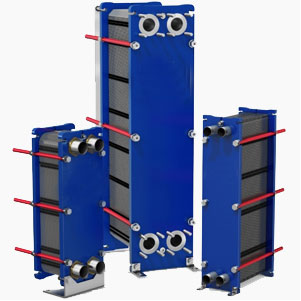

Based on the analysis of heat transfer effect of marine plate heat exchanger
As the main heat exchange equipment, ship plate heat exchanger plays an important role in the safe operation of the whole ship. The structure of the utility model is relatively simple, which is mainly composed of a screw rod, a pressing plate, a base, a plate, etc.. The utility model is widely used as a cylinder liner, a lubricating oil cooler and a central cooler. For decades has been a great development. The major manufacturers will focus on how to improve the heat exchanger plate.

The plate structure of the plate heat exchanger directly affects the performance of the heat exchanger. In this paper, the influence of a series of plate parameters on the performance of heat exchanger is discussed in order to provide some reference for further research.
The heat transfer coefficient expressions shows that thickness of plate is smaller, the better effect of heat transfer of heat exchanger, marine heat exchanger, proposed heat exchanger plates with thickness of 0.6 ~ 0.8mm, the industry's most thin titanium plate has reached 0.4mm. The effect of improving the heat transfer effect is not obvious, but the main purpose is to reduce the cost and reduce the consumption of the material.
One of the main methods to improve the K value of marine plate heat exchanger is to improve the degree of fluid disturbance on the surface of the heat exchanger. The plate plate of ship plate heat exchanger is usually processed with corrugated board. The herringbone angle has a great influence on the heat transfer and fluid resistance. The heat transfer coefficient is high and the fluid resistance is large, and the heat transfer coefficient and drag coefficient of the plate with small angle are small. The best corrugated heat transfer effect 120 degrees miter angle, the angle is smaller or larger, the heat transfer efficiency will be low, the central cooler and the jacket water cooler usually adopts 120 degree angle to achieve the herringbone plate, the maximum heat transfer effect.
In the marine oil cooler, because the viscosity of the oil is higher than the viscosity of the water, if the full use of 120 degree angle of the plate will cause large fluid resistance, and low heat transfer coefficient of the small angle plate of 60 degrees. Therefore, oil coolers often use 2 plates in the mixed way, make full use of allowable pressure drop conditions, this is called heat mixed design, the heat exchange area can achieve optimal effect.
Fluid flow in the plate, the flow rate is not uniform, the flow rate in the mainstream line, about 4~5 times the average flow rate, the flow rate of each channel in a process is not uniform. In order to make the fluid flow between the plates, the average velocity of the plate should be 0.3 ~ 0.8m/s. Under the condition that the resistance drop is allowed to take a large value, the convection heat transfer film coefficient is improved, thus the heat exchange area is reduced and the heat transfer efficiency is improved. Usually choose the appropriate area and length width ratio of the plate according to the given velocity, so the selection method is the key factor to control the flow velocity between the plates.
epilogue
(1) through analyzing the heat transfer model of the heat exchanger, several key factors which affect the heat transfer coefficient K of the heat exchanger are analyzed. The length of the plate and the Reynolds number of the plate Re determine the size of the heat transfer film coefficient.
(2) the research direction of the plate plate (plate thickness, the angle between the plate and the plate velocity) is analyzed.
(3) after analysis, it is necessary to improve and optimize the ship plate heat exchanger according to the principles of heat transfer and fluid mechanics.







